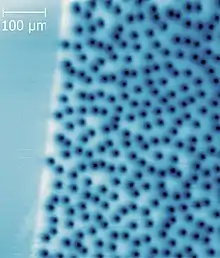Abrikosov vortex
In superconductivity, an Abrikosov vortex (also called a fluxon) is a vortex of supercurrent in a type-II superconductor theoretically predicted by Alexei Abrikosov in 1957.[2] Abrikosov vortices occur generically in the Ginzburg–Landau theory of superconductivity, and can be explicitly demonstrated as solutions to that theory in a general mathematical setting, viz. as vortices in complex line bundles on Riemannian manifolds.

Overview
The supercurrent circulates around the normal (i.e. non-superconducting) core of the vortex. The core has a size — the superconducting coherence length (parameter of a Ginzburg–Landau theory). The supercurrents decay on the distance about (London penetration depth) from the core. Note that in type-II superconductors . The circulating supercurrents induce magnetic fields with the total flux equal to a single flux quantum . Therefore, an Abrikosov vortex is often called a fluxon.
The magnetic field distribution of a single vortex far from its core can be described by
where is a zeroth-order Bessel function. Note that, according to the above formula, at the magnetic field , i.e. logarithmically diverges. In reality, for the field is simply given by
where κ = λ/ξ is known as the Ginzburg–Landau parameter, which must be in type-II superconductors.
Abrikosov vortices can be trapped in a type-II superconductor by chance, on defects, etc. Even if initially type-II superconductor contains no vortices, and one applies a magnetic field larger than the lower critical field (but smaller than the upper critical field ), the field penetrates into superconductor in terms of Abrikosov vortices. Each vortex carries one thread of magnetic field with the flux . Abrikosov vortices form a lattice, usually triangular, with the average vortex density (flux density) approximately equal to the externally applied magnetic field. As with other lattices, defects may form as dislocations.
Abrikosov vortex and proximity effect
Here is shown, that a quantum vortex with a well-defined core can exist in a rather thick normal metal, proximized with a superconductor.[3]
See also
References
- Wells, Frederick S.; Pan, Alexey V.; Wang, X. Renshaw; Fedoseev, Sergey A.; Hilgenkamp, Hans (2015). "Analysis of low-field isotropic vortex glass containing vortex groups in YBa2Cu3O7−x thin films visualized by scanning SQUID microscopy". Scientific Reports. 5: 8677. arXiv:1807.06746. Bibcode:2015NatSR...5E8677W. doi:10.1038/srep08677. PMC 4345321. PMID 25728772.
- Abrikosov, A. A. (1957). "The magnetic properties of superconducting alloys". Journal of Physics and Chemistry of Solids. 2 (3): 199–208. Bibcode:1957JPCS....2..199A. doi:10.1016/0022-3697(57)90083-5.
- Stolyarov, Vasily S.; Cren, Tristan; Brun, Christophe; Golovchanskiy, Igor A.; Skryabina, Olga V.; Kasatonov, Daniil I.; Khapaev, Mikhail M.; Kupriyanov, Mikhail Yu.; Golubov, Alexander A.; Roditchev, Dimitri (11 June 2018). "Expansion of a superconducting vortex core into a diffusive metal" (PDF). Nature Communications. 9 (1): 2277. doi:10.1038/s41467-018-04582-1.